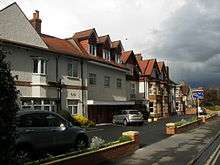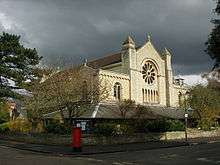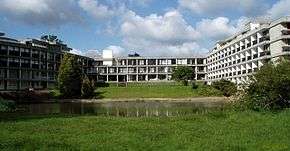Linton Road



Linton Road is a road in North Oxford, England.[2]
Location
At the western end is the Banbury Road. At the eastern end is Wolfson College, a graduate college of the University of Oxford. To the north at the eastern end, Garford Road runs parallel with Linton Road. The road also adjoins Northmoor Road, Charlbury Road and Chadlington Road.
Linton Lodge Hotel[1] is located in this road, as well as the Parklands Hotel on the corner of Banbury Road and Linton Road. The Bishop of Oxford also has a house here, near the western end. St Andrew's Church[3] is on the southeast corner of the junction with Northmoor Road. The road has speed humps to prevent traffic from moving too quickly.
History
Houses in the road were first leased between 1895 and 1925.[2] Architects include J. C. Gray, N. W. Harrison, E. J. Marriott, Arthur C. Martin, A. H. Moberly (who also worked with William Crabtree on the Peter Jones department store in London[4]), and Harry Wilkinson Moore. Of special architectural interest, as noted by Pevsner, is No. 7 Linton Road, on the northwest corner of the junction with Northmoor Road, designed by A. H. Moberly in 1903.[5]
On 4 May 1941 during World War II, an Armstrong Whitworth Whitley bomber of the Royal Air Force, based at RAF Abingdon, crashed at the eastern end of Linton Road on the site of what is now Wolfson College.[6] The crew were killed and three people on the ground were injured.
Residents
The Haldane family[7] lived at 'Cherwell', a house located at the eastern end of Linton Road, in the early 20th century, having previously lived at 11 Crick Road.[8] The family included the physiologist and father, John Scott Haldane, together with his children, the geneticist and evolutionary biologist, J. B. S. Haldane (Fellow of New College, Oxford), and the novelist Naomi Mitchison. The house was built by George Gardiner and included a private laboratory. It was demolished to make way for Wolfson College, located next to the River Cherwell. The College was designed by the Powell and Moya Architects, and completed in 1974.
Other former residents include the physical chemist Sir Harold Warris Thompson (1908–1983), at No. 33,[9] and historian Michael Brock (1920–2014) with his wife (and co-editor) Eleanor.[10]
Gallery
-

St Andrew's Church,[1] on the corner of Linton Road and Northmoor Road.
-

Wolfson College, at the eastern end of Linton Road.[2]
- ^ Cite error: The named reference
standrewswas invoked but never defined (see the help page). - ^ Cite error: The named reference
obpswas invoked but never defined (see the help page).
References
- 1 2 Linton Lodge Hotel website.
- 1 2 Hinchcliffe, Tanis (1992). North Oxford. New Haven & London: Yale University Press. pp. 127, 130, 144, 231. ISBN 0-14-071045-0.
- ↑ St Andrew's Church website.
- ↑ "The modern shop: architecture & shopping between the wars". Victoria and Albert Museum. Retrieved August 15, 2011.
- ↑ Sherwood, Jennifer; Pevsner, Nikolaus (1974). The Buildings of England: Oxfordshire. Penguin Books. p. 320. ISBN 0-14-071045-0.
- ↑ Symonds, Ann Spokes (2012). "Remembering where the bomber crashed". Wolfson College Record. Oxford.
- ↑ Symonds, Ann Spokes (1997). "Families: The Haldanes". The Changing Faces of North Oxford. Book One. Robert Boyd Publications. pp. 99–101. ISBN 1 899536 25 6.
- ↑ "J. S. Haldane (1860–1936)". Oxfordshire Blue Plaques Scheme, UK. 14 March 2011. Retrieved May 6, 2011.
- ↑ "Linton Road". Kelly's Directory of Oxford (68th ed.). Kingston-upon-Thames, Surrey: Kelly's Directories. 1976. p. 381.
- ↑ "Eminent dean and scholar whose historical work is published soon". Oxford Mail. 22 May 2014. Retrieved 26 May 2014.
Coordinates: 51°46′13″N 1°15′32″W / 51.7702°N 1.2590°W